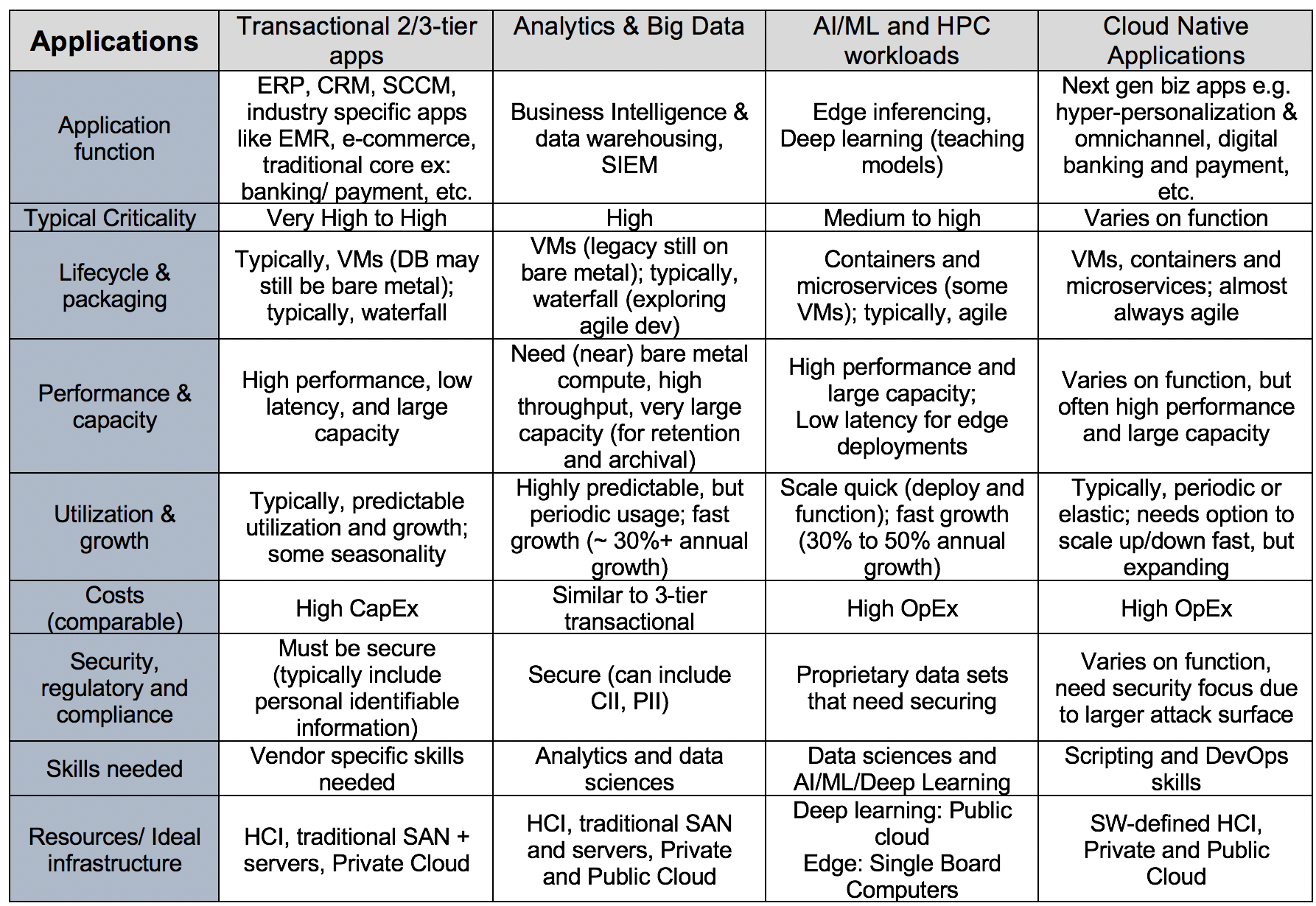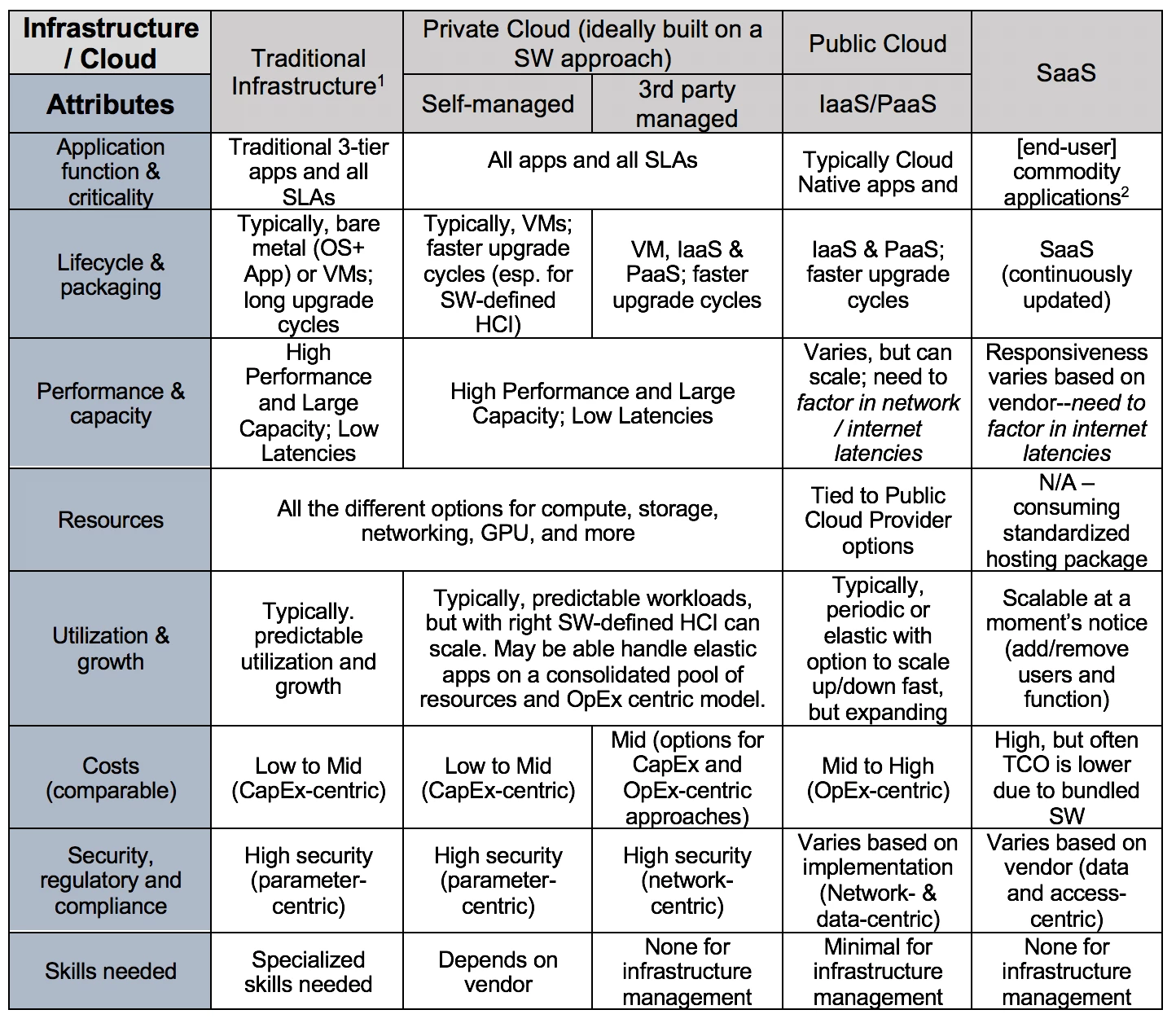This blog was authored by Sachin Chheda, Rodney Fite, and Pat Heinrich
This blog is a continuation of the discussion on infrastructure and cloud choices. This is the second of the two-part blog series.
In the first blog of the series, we covered the approaches for IT and applications teams to align their apps and services to infrastructure/cloud choices. This second blog of the two-part series will cover how various options for infrastructure and cloud align with the different application attributes.
Let’s start with a quick recap of the IT infrastructure and cloud choices.
- Traditional infrastructure — Servers and storage with network connectivity that may or may not leverage virtualization. However, traditional infrastructure lacks basic cloud tenets.
- Cloud — Infrastructure, Platform, or Software delivered ‘as-a-Service’ to end-users with a mechanism to provision, use or consume, and meter for reporting or chargeback. This includes an extensive set of APIs and other hooks for automation, and more. End-users may provision through a self-service IT application, services store or marketplace.
- Private clouds — a dedicated ‘cloud’ that can be self-managed or managed by a 3rd party, located on-prem or collocated in an external datacenter. Third party providers may deliver infrastructure, platform, or software as a service.
- Public clouds — shared ‘cloud’ delivering infrastructure, platform, or software as a service.
There are more cloud definitions like virtual private cloud or hybrid and multi-clouds. These may combine characteristics, scope, or clouds themselves. One cloud definition worth calling out is distributed clouds where the ‘service’ or application is located outside of the datacenter including at the edge where the application/service is used or consumed.
Example: Edge computing located next to the radio access networks in 5G private networks will become pervasive due to the need for real time processing and very low latency services. These ‘edge’ clouds will deliver services such as security/firewalls or real time object recognition and other IoT-oriented function, connecting to private and public clouds on the backend.
Before jumping over to the application attributes, we want to bring up article by Niel Nickolaisen from issue 1.0 of the NEXT magazine, titled 'Decision Framework for Purpose Alignment'. The article discusses decision-making for the optimal use of IT resources, encouraging outsourcing IT apps and services that are low on the criticality scale. I want to re-emphasize that organizations should revisit application roadmap regularly to decide whether they should rehost, re-platform, rewrite or retire their application versus simply giving in to legacy considerations
Here is high level recap of the application attributes that inform application placement.
- Type of application/service including:
- Function, users, and business criticality
- Packaging/deployment and lifecycle management considerations
- Current and future state (can it be retired, consumed as a service, modernized etc)
- Performance and capacity needs.
- Specific resource requirements.
- Planned utilization and growth.
- Costs considerations (initial and ongoing).
- Security, Regulatory, and Compliance requirements.
- Specialized skills.
Mapping the Attributes
The tables below explore attributes for common applications (table 1) and infrastructure/cloud alignment (table 2). The information available to us as consumers is ever evolving, so feel free to reach out to us to see how we can do something specific for your environment including touching on workloads like end-user computing.


Note:
- Traditional infrastructure is typically the starting point and existing standard for most organizations. This solution comprises of a server, network, storage, and virtualization layers (if applicable). Organizations are modernizing their traditional infrastructure with software defined approached like HCI.
- Recommend perusing through Niel’s arcticle referenced in the sidebar above to help your organization decide on outsourcing IT applications and services.
Hybrid Clouds
IT organizations also have ability to use hybrid cloud approach to run their applications. Hybrid clouds enable IT to leveraging multiple separate cloud resources as a single cloud. These clouds can be any combination of private and public clouds (private-private, private-public, or even public-public). Hybrid clouds enable IT organizations to leverage the best attributes of different clouds. For example: A transactional 3-tier application that supports an order-entry system may be deployed across a hybrid cloud as follows.
- Database running a 3rd party managed private cloud for performance/responsiveness and security requirements.
- Stateless application servers running on the same third party managed cloud and burst to a service provider’s public cloud based on incoming demand.
- The IP network front-end of the application stack (load balancer, web servers, etc) may be using public cloud services delivered by a telco in conjunction with a hyperscale cloud provider.
More information on this topic can be found here and here. From an application and IT operations standpoint, using the right tools are critical to successfully leverage multiple clouds in unison. When qualifying a hybrid cloud approach, we recommend reviewing basic operational and lifecycle considerations like those presented below:
- Can an application stack like the example described above be provisioned across multiple clouds?
- How simple is it to manage the application life cycle, including tasks like upgrades and scaling?
- Can the costs for all of the different cloud choices be reviewed beforehand and used to optimize deployment?
- Can the team run security checks to ensure the deployment is secure and compliant?
- How easy is it for the IT infrastructure operations team to ramp up on the tools and processes?
Getting Started
In the previous blog in this series, we touched on the US Federal Cloud Computing Strategy when defining the term ‘Cloud Smart’. This Cloud strategy identifies three pillars of a successful cloud adoption strategy – security, procurement and workforce. They represent an interdisciplinary approach to modernizing the computing landscape. While the intent is not to endorse the federal approach, this framework includes key points that should be considered in the execution phase a cloud transition. However, each organization is unique and must solve their own architectural challenges. In a more general sense:
Referring back to enablement statements, “to fully actualize the promise and potential of cloud-based technologies while ensuring thoughtful execution that incorporates practical realities.” To make this shift, instead of “buy before build”, agencies will need to move to “solve before buy,” addressing their service needs, fundamental requirements, and gaps in processes and skillsets before starting on a new procurement. - from https://cloud.cio.gov/strategy/
In determining the optimal platform for any workload, it is critical for IT to have a perspective on the various application and infrastructure attributes. Make a plan for mapping the attributes together and create a meaningful solution. Successful solution designs often have an architectural point of view that includes application and infrastructure considerations and requirements.
It is important to fully understand the advantages of private and public clouds along with the implications of selecting one or the other. Application functionality, performance requirements, growth trends, costs, and skills are just a few of these considerations that are part of the decision-making process. Hopefully you will find this helpful as part of the discovery process.
We want to hear from you!
We want to hear from you, so be sure to share your feedback on our Nutanix NEXT community. As technology and offerings evolve, the attributes for consideration will evolve as well. Discuss with your peers strategies and tactics on deciding where to run your applications and share best practices on how to bring application and infrastructure team together.
Like we’ve done in our previous blogs, we want to reiterate our offer to IT organizations who want to genuinely want to evolve by helping with devising and putting in place an optimal strategy on where to run your organizations applications. We can share different frameworks that we found effective with other IT organizations. And for those who qualify, we can bring a cloud transformation workshop to your location and share best practices.
Send us a note at info@nutanix.com or interact with us on Twitter – @Nutanix or @StorSC or @RodneyFite.
 2020 Nutanix, Inc. All rights reserved. Nutanix, the Nutanix logo and all Nutanix product and service names mentioned herein are registered trademarks or trademarks of Nutanix, Inc. in the United States and other countries. All other brand names mentioned herein are for identification purposes only and may be the trademarks of their respective holder(s).
2020 Nutanix, Inc. All rights reserved. Nutanix, the Nutanix logo and all Nutanix product and service names mentioned herein are registered trademarks or trademarks of Nutanix, Inc. in the United States and other countries. All other brand names mentioned herein are for identification purposes only and may be the trademarks of their respective holder(s).
Disclaimer: This post contains links to external websites that are not part of Nutanix.com. Nutanix does not control these sites and disclaims all responsibility for the content or accuracy of any external site. Our decision to link to an external site should not be considered an endorsement of any content on such a site.


